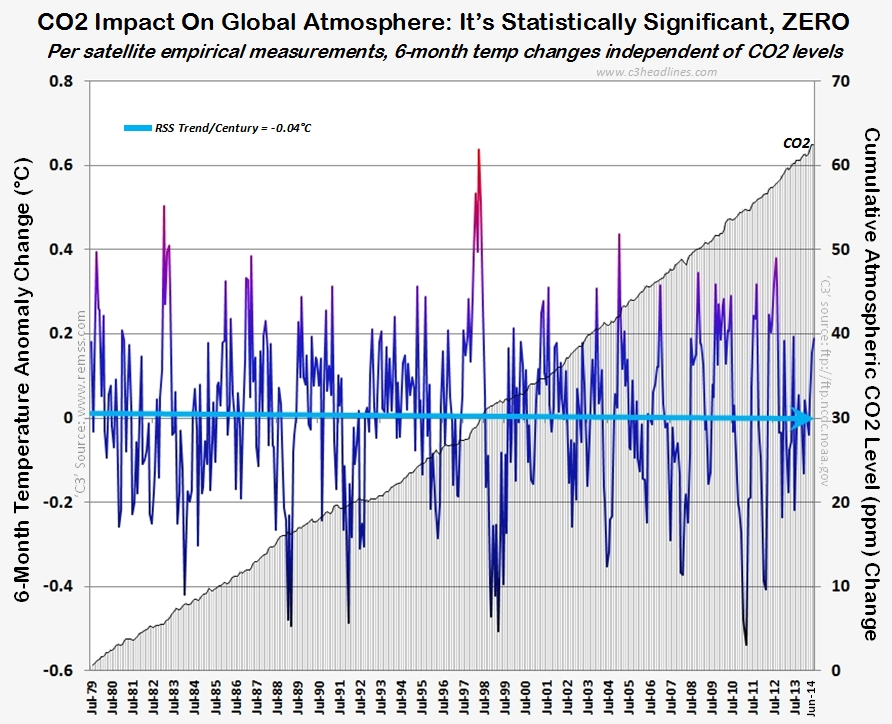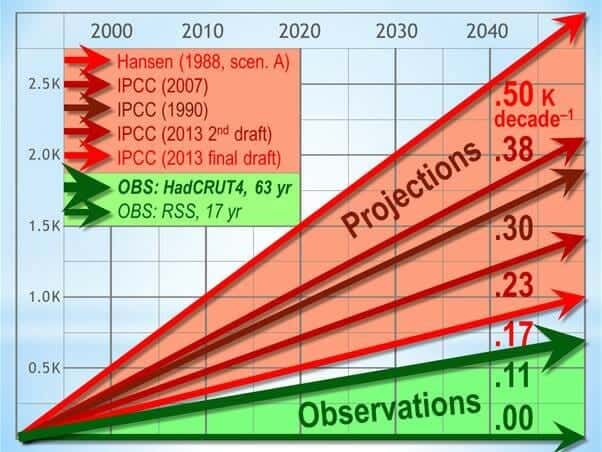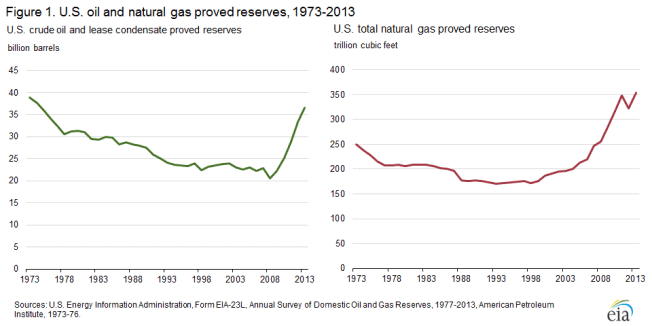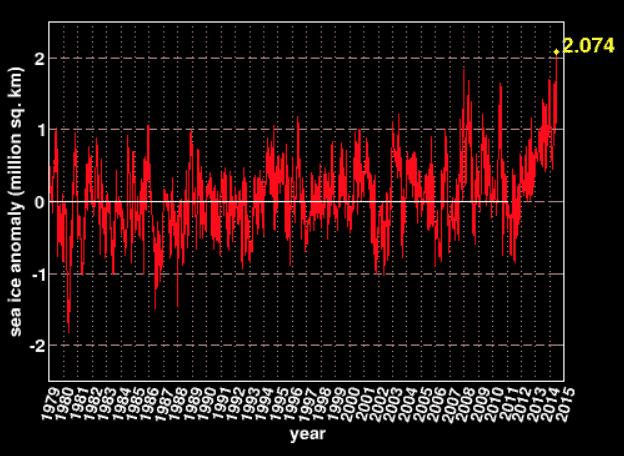(Here’s the long list)
1) UN overestimated global warming by 2015
Two decades ago, the UN came up with several models that all predicted that by 2015, the Earth would have warmed by at least a degree Fahrenheit. Yet in the last two decades, there has instead been virtually no warming according to satellite temperature measurements….
RPT’s addition: NASA has said that the “Abyss” has not gotten warmer since 2005, and do not know why [if taking into account global warming realities] why the earth has stalled in temperature… even getting slightly colder globally since 2005 (see chart of CO2 output and temperature, below). It is called a “mystery” by NASA.

2) All Rainforest Species Will Be Extinct
Dr. Paul Ehrlich, the President of the Center for Conservation Biology at Stanford University, got famous for his 1968 book “the Population Bomb” which predicted that increasing human populations would spell doom.
One part of that doom, he warned in his 1981 book “Extinction,” was that all rainforest species would likely soon go extinct due to environmental destruction.
“Half of the populations and species in tropical moist forests would be extinct early in the next century [the 2000s] and none would be left by 2025,” he warns on page 291. He added that that his model indicated that, on the upper bound, complete extinction would occur as soon as 2010….
RPT’s addition: The New York Times makes point that “…for every acre of rain forest cut down each year, more than 50 acres of new forest are growing in the tropics on land that was once farmed, logged or ravaged by natural disaster.” This doesn’t sound too alarmist to me. Speaking of alarmists, William Shatner, Captain Kirk of Star Trek fame, mentioned in a National Geographic video that, “rainforests [are] being cleared at the rate of 20 football fields per minute.” If this were truly the case, the forests would have been completely wiped out years ago. In fact, the co-founder and long-time director of Greenpeace, Patrick Moore, said:
“All these save-the-forests arguments are based on bad science…. They are quite simply wrong… [Phillip Stott and I] found that the Amazon rainforests is more than 90% intact. We flew over it and met all the environmental authorities. We studied satellite pictures of the entire area.”
Phillip Stott, who has 30 years of studying tropical forests under his belt as well as being professor of biogeography at London University mentioned that, “there are now still – despite what humans have done – more rainforests today than there were 12,000 years ago.”
3) Oil will run out by 2015
A Pennsylvania state government “Student and Teacher Guide” reads: “Some estimates of the oil reserves suggest that by the year 2015 we will have used all of our accessible oil supply.”
Yet the Earth still has oil: at least 1.6 trillion gallons of proven reserves, according to the Energy Information Administration, a US government agency. In fact, proven reserves have more than doubled over the last couple decades, as technological innovation made more oil accessible….
RPT’s addition: Yes, the U.S. has hit an all-time high in production:
More than that though, “According to the Institute for Energy Research’s calculations, the U.S. actually sits on 1.442 trillion barrels of recoverable deposits. That’s over 60 times the amount we usually hear about. Merline writes that this larger number would be enough to meet all U.S. oil needs for about the next 200 years” (Business Insider).
Let me repeat that, 200-years of oil!
4) Arctic sea ice will disappear by 2015.
“Peter Wadhams, who heads the Polar Ocean Physics Group at the University of Cambridge… believes that the Arctic is likely to become ice-free before 2020 and possibly as early as 2015,” (Yale Environment 360 reported in 2012). Yet government data shows that arctic sea ice has increased since then….
RPT’s addition: Here I will post information from a previous post about Polar Bear population levels, in which I point the following out:
Recent Population Increase Partly Due To Lots of Sea-Ice
Canada (CBC News via the Canadian Coast Guard, 3/2014) [ARCTIC Sea Ice] The Canadian Coast Guard is pleading with merchant ships to plan their voyages well in advance this year as the organization’s icebreaker fleet confronts some of the worst ice conditions on the Atlantic Ocean in decades.
“Plan your voyage and we’ll all get through this,” said Mike Voight, the Atlantic region’s director of programs. “We’ve got a pretty bad or challenging ice year.”
The Canadian Ice Service, an arm of Environment Canada, said there is 10 per cent more ice this year compared to the 30-year average.
“We probably haven’t seen a winter this bad as far as ice for the past 25 years,” said Voight, referring to both the amount and thickness of the ice….
The American Geophysical Union (AGU) Abstract (12/2014) [ARCTIC sea ice] Despite a well-documented ~40% decline in summer Arctic sea ice extent since the late 1970’s, it has been difficult to estimate trends in sea ice volume because thickness observations have been spatially incomplete and temporally sporadic. While numerical models suggest that the decline in extent has been accompanied by a reduction in volume, there is considerable disagreement over the rate at which this has occurred. We present the first complete assessment of trends in northern hemisphere sea ice thickness and volume using 4 years of measurements from CryoSat-2. Between autumn 2010 and spring 2013, there was a 14% and 5% reduction in autumn and spring Arctic sea ice volume, respectively, in keeping with the long-term decline in extent. However, since then there has been a marked 41% and 9% recovery in autumn and spring sea ice volume, respectively, more than offsetting losses of the previous three years. The recovery was driven by the retention of thick ice around north Greenland and Canada during summer 2013 which, in turn, was associated with a 6% drop in the number of days on which melting occurred – climatic conditions more typical of the early 1990’s. Such a sharp increase in volume after just one cool summer indicates that the Arctic sea ice pack may be more resilient than has been previously considered.
Talking About Weather (7/2014) [ANTARCTIC sea ice] Antarctic sea ice has hit its second all-time record maximum this week. The new record is 2.112 million square kilometers above normal. Until the weekend just past, the previous record had been 1.840 million square kilometers above normal, a mark hit on December 20, 2007, as I reported here, and also covered in my book.
Mark Serreze, director of the National Snow and Ice Data Center, responded to e-mail questions and also spoke by telephone about the new record sea ice growth in the Southern Hemisphere, indicating that, somewhat counter-intuitively, the sea ice growth was specifically due to global warming.
Let us compare this to Al Gore saying the northern ice-caps will be gone
NewsBusters makes the point another way, in that the “media” is derelict in their duty:
The same year that former Vice President Al Gore predicted that the Arctic sea ice could be completely gone, Arctic ice reached its highest level in two years, according to a report by the Danish Meteorological Institute.
According to that report, which was cited by the Daily Mail (UK) on Aug. 30, “[t]he Arctic ice cap has expanded for the second year in a row.” The U.S. National Snow and Ice Data Center (NSIDC) confirmed this trend, but didn’t go into as much detail as the Danish Meteorological Institute.
But an examination of ABC, CBS and NBC news programs since the Daily Mail story was published found that all three networks ignored news that Arctic sea ice was at a two-year high….
Remember, you can lead a horse to water but cannot make it drink.
…read it all at Fox News.


